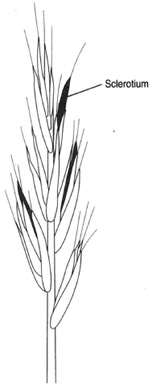Ergot
 |
| Figure 19-10 Rye cereal showing sclerotia of Claviceps purpurea |
Claviceps purpurea is an important ascomycete that grows on the grains of rye grass cereals. It produces the drug ergot, which is both a severe poison and a useful medicinal drug. It affects the central nervous system as well as causes the contraction of involuntary muscle.
Middle Ages, when it was known as “St. Anthony’s Fire.” Epidemics of ergotism swept over France nine times in the seventeenth century and seven times in the eighteenth century. Even more episodes occurred in Germany. During an epidemic in the year 994 A.D., 40,000 people died from eating infected bread. It is recorded that when Czar Peter the Great was preparing to launch a military campaign against Turkey in 1722, his troops were felled by ergotism. The military action did not take place and a war was thus lost because of a fungus.
Because ergot causes contraction of involuntary muscle, it has been useful in helping contraction of the uterus during labor. It has also been used to help retard bleeding and has proved valuable in treating migraine headaches.
Dried ergoty grains are also used for leas noble purposes-specifically, in the manufacture of lysergic acid diethylamide (LSD), an hallucinogenic drug. Ergot is dangerous in that an overdose can cause gangrene and death. In affecting the nervous system, ergot can cause hysteria and temporary insanity. Could ergotism have been involved in the witchcraft that occurred in Salem, Massachusetts in 1692?




